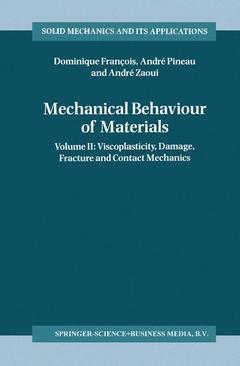Mechanical Behaviour of Materials, 1998 Volume II: Viscoplasticity, Damage, Fracture and Contact Mechanics Solid Mechanics and Its Applications Series, Vol. 58
Auteurs : François Dominique, Pineau André, Zaoui André

Foreword.- 1. Various types of damage.- 2. Fracture mechanics.- 3. Brittle fracture.- 4. Ductile fracture.- 5. Ductile-brittle transition.- 6. Fatigue.- 7. Environment assited cracking.- 8. Creep-fatigue-oxidation interactions.- 9. Contact mechanics - friction and wear.- 10. Damage and fracture on non-metallic materials.- Appendix A Diffusion coefficients.
Date de parution : 12-2010
Ouvrage de 410 p.
16x24 cm
Mots-clés :
Metall; elasticity; fatigue; fracture mechanics; polymer; polymers; viscoelasticity



